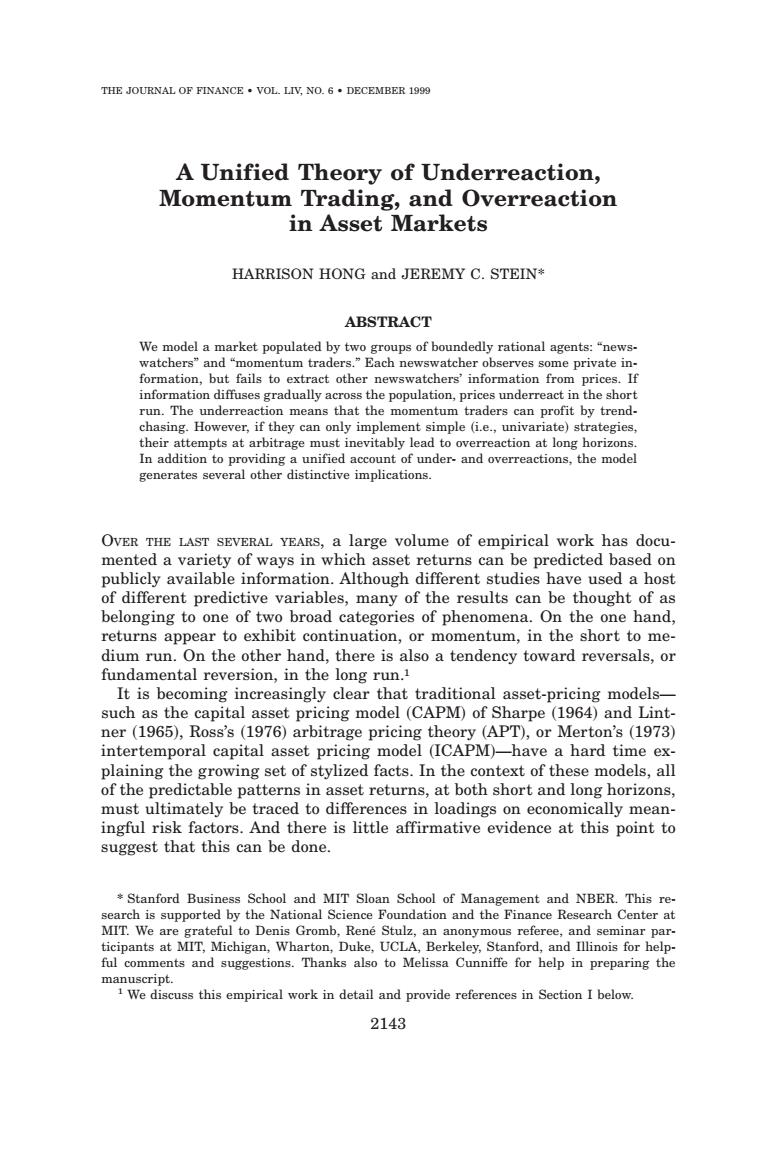正在加载图片...

THE JOURNAL OF FINANCE.VOL.LIV,NO.6.DECEMBER 1999 A Unified Theory of Underreaction, Momentum Trading,and Overreaction in Asset Markets HARRISON HONG and JEREMY C.STEIN* ABSTRACT We model a market populated by two groups of boundedly rational agents:"news- watchers"and "momentum traders."Each newswatcher observes some private in- formation,but fails to extract other newswatchers'information from prices.If information diffuses gradually across the population,prices underreact in the short run.The underreaction means that the momentum traders can profit by trend- chasing.However,if they can only implement simple(i.e.,univariate)strategies, their attempts at arbitrage must inevitably lead to overreaction at long horizons. In addition to providing a unified account of under-and overreactions,the model generates several other distinctive implications. OVER THE LAST SEVERAL YEARS,a large volume of empirical work has docu- mented a variety of ways in which asset returns can be predicted based on publicly available information.Although different studies have used a host of different predictive variables,many of the results can be thought of as belonging to one of two broad categories of phenomena.On the one hand, returns appear to exhibit continuation,or momentum,in the short to me- dium run.On the other hand,there is also a tendency toward reversals,or fundamental reversion,in the long run.1 It is becoming increasingly clear that traditional asset-pricing models- such as the capital asset pricing model(CAPM)of Sharpe(1964)and Lint- ner (1965),Ross's (1976)arbitrage pricing theory (APT),or Merton's (1973) intertemporal capital asset pricing model (ICAPM)-have a hard time ex- plaining the growing set of stylized facts.In the context of these models,all of the predictable patterns in asset returns,at both short and long horizons, must ultimately be traced to differences in loadings on economically mean- ingful risk factors.And there is little affirmative evidence at this point to suggest that this can be done. Stanford Business School and MIT Sloan School of Management and NBER.This re- search is supported by the National Science Foundation and the Finance Research Center at MIT.We are grateful to Denis Gromb,Rene Stulz,an anonymous referee,and seminar par. ticipants at MIT,Michigan,Wharton,Duke,UCLA,Berkeley,Stanford,and Illinois for help- ful comments and suggestions.Thanks also to Melissa Cunniffe for help in preparing the manuscript. We discuss this empirical work in detail and provide references in Section I below. 2143A Unified Theory of Underreaction, Momentum Trading, and Overreaction in Asset Markets HARRISON HONG and JEREMY C. STEIN* ABSTRACT We model a market populated by two groups of boundedly rational agents: “newswatchers” and “momentum traders.” Each newswatcher observes some private information, but fails to extract other newswatchers’ information from prices. If information diffuses gradually across the population, prices underreact in the short run. The underreaction means that the momentum traders can profit by trendchasing. However, if they can only implement simple ~i.e., univariate! strategies, their attempts at arbitrage must inevitably lead to overreaction at long horizons. In addition to providing a unified account of under- and overreactions, the model generates several other distinctive implications. OVER THE LAST SEVERAL YEARS, a large volume of empirical work has documented a variety of ways in which asset returns can be predicted based on publicly available information. Although different studies have used a host of different predictive variables, many of the results can be thought of as belonging to one of two broad categories of phenomena. On the one hand, returns appear to exhibit continuation, or momentum, in the short to medium run. On the other hand, there is also a tendency toward reversals, or fundamental reversion, in the long run.1 It is becoming increasingly clear that traditional asset-pricing models— such as the capital asset pricing model ~CAPM! of Sharpe ~1964! and Lintner ~1965!, Ross’s ~1976! arbitrage pricing theory ~APT!, or Merton’s ~1973! intertemporal capital asset pricing model ~ICAPM!—have a hard time explaining the growing set of stylized facts. In the context of these models, all of the predictable patterns in asset returns, at both short and long horizons, must ultimately be traced to differences in loadings on economically meaningful risk factors. And there is little affirmative evidence at this point to suggest that this can be done. * Stanford Business School and MIT Sloan School of Management and NBER. This research is supported by the National Science Foundation and the Finance Research Center at MIT. We are grateful to Denis Gromb, René Stulz, an anonymous referee, and seminar participants at MIT, Michigan, Wharton, Duke, UCLA, Berkeley, Stanford, and Illinois for helpful comments and suggestions. Thanks also to Melissa Cunniffe for help in preparing the manuscript. 1 We discuss this empirical work in detail and provide references in Section I below. THE JOURNAL OF FINANCE • VOL. LIV, NO. 6 • DECEMBER 1999 2143